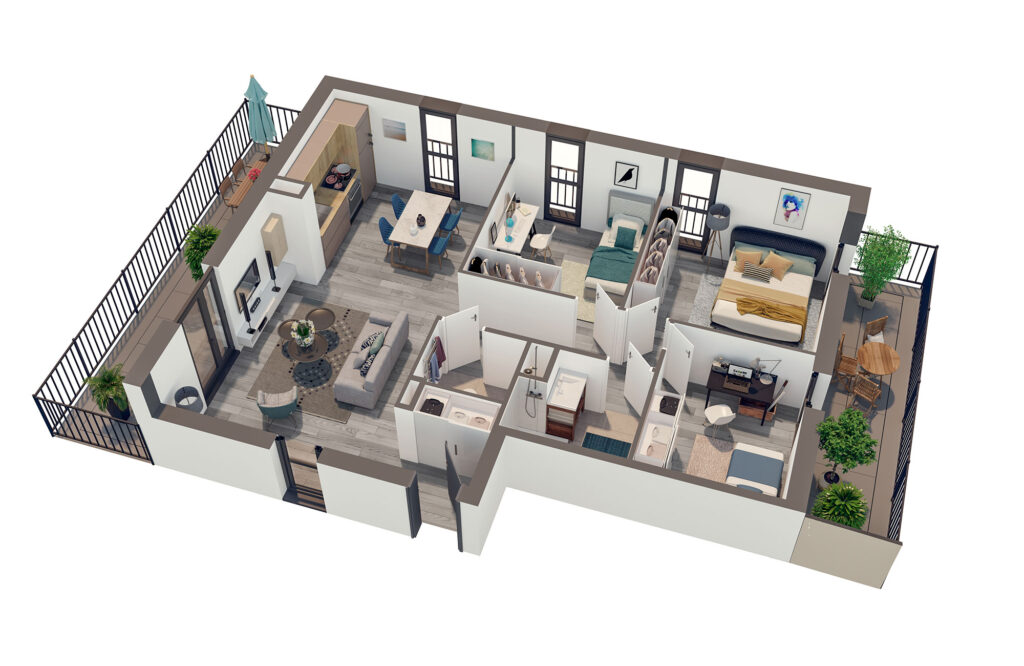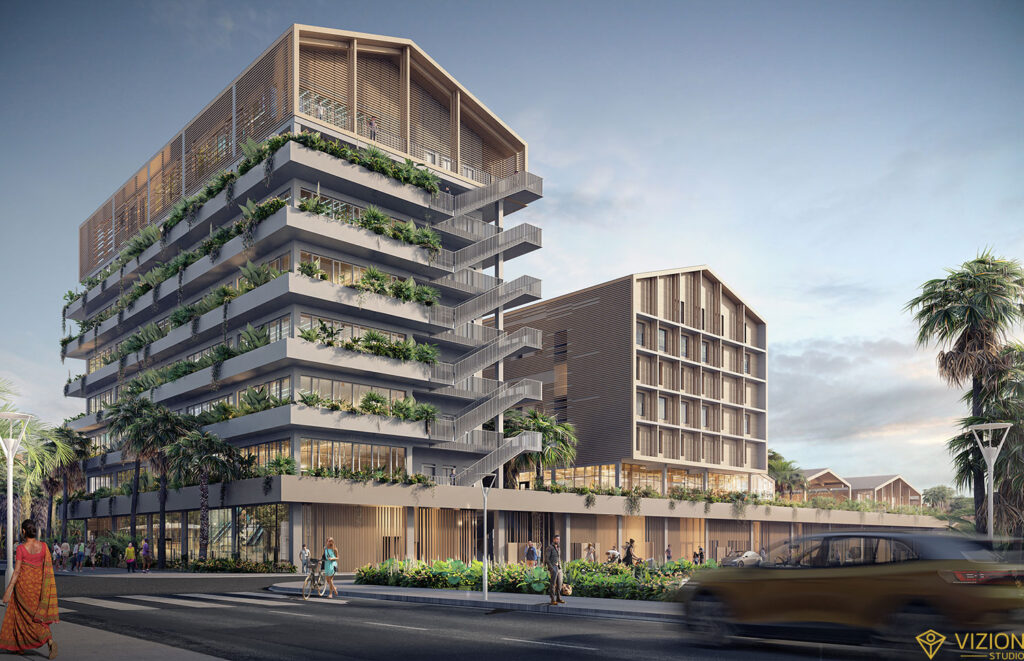The real estate sector is particularly demanding, requiring players to constantly adapt to the various technological advances, particularly those relating to digitization and 3D.
Since the advent of CAD and BIM software, property developers have been vying with each other to offer customers more realistic and attractive representations of their properties.
In fact, the use of these tools is now essential to the successful management of any real estate project. Find out more in this guide.
What are the main 3D tools for real estate project management?

There's a wide range of 3D architecture software and applications on the market, enabling novices and professionals alike to manage a real estate project.
3D architecture software for novices
For beginners, there are 3D modeling software packages with fairly limited functionality, but which are easy to use. Here are a few examples:
|
Software |
Speciality |
Benefits |
Cedreo | 3D design, online home design |
Minimalist functionality Easy to handle, even for first-time users |
SketchUp | 3D architectural drawing, usually for real estate in general |
A huge library of different extensions Possibility of creating sky views and walkthroughs |
Floorplanner | Interior design |
Ease of use and efficiency Comprehensive library of objects |
Kintezia | 3D architectural plans, real estate in general |
Architecture software trends Virtual tour available |
3D architecture software for professionals
For real estate professionals, particularly those in the construction industry, there are more powerful software packages available, both free and for a fee. These include :
|
Software |
Speciality |
Benefits |
AutoCAD |
3D modeling and visualization of building interiors and exteriors |
Multifunction software Architectural version available for all architectural designs |
Chief Architect |
CAD solution for residential design. |
Automated construction tools can be used for both construction and renovation work. |
FreeCAD |
3D modelling, using CAD, but also with BIM functionalities |
Modular architecture enabling functions to be extended to include specialized modules. |
3D modeling mobile applications
Mobile 3D modeling applications are known for being more practical and accessible. The long list of mobile applications includes :
|
Application |
Speciality |
Advantage |
BIMx | BIM presentation, on-site concept review | Easy access and sharing of relevant model data |
ViewER | Rapid visualization of all kinds of 3D architectural models, in all formats | Mix CAD models and real images in augmented reality mode |
Arki | Visualization of real estate projects in augmented reality | Models can be viewed at any scale. |
3D visuals for real estate project management?
There are a thousand and one ways to use 3d tools to manage a real estate project. For any real estate developer, certain visuals are indispensable from the design phase right through to the sales phase.
3D Architectural Plan Design
This is the easiest way to use 3D architecture software or applications. The 3D plan gives you an idea of the architecture of the building to be constructed or renovated: spaces, massing, proportions, etc.
Much more than a 2D architectural plan, this includes a precise layout of each room, integrating furniture and decoration. Potential buyers can zoom in and out, viewing the plan from every angle for maximum visual information.
360° virtual tours
This is a 360-degree visualization of a visit to a building or site. It provides a realistic immersion of customers and prospects, accelerating sales and reinforcing your company's image.
Your prospects will be able to view the virtual tour comfortably from anywhere in the world, optimizing your customer experience.
3D perspectives
Photorealistic 3D perspective is a technique for representing a property in a realistic way, with a strong illusion of depth and three-dimensionality.
This technique can be used to detect any errors in the project, such as non-compliance with architectural standards or inconsistency with the overall environment.
Augmented reality
An innovative practice in the real estate industry, the use of software-enhanced augmented reality lets you project yourself onto a construction site in full swing. By pointing a mobile device at a real environment, your prospects obtain on their screen a 3D image of the completed version of the work.
Creation of 3D orbital models
This is the design of a scale model of the planned real estate project. It can be customized according to the user's objectives:
- Various types of visualization: pedestrian mode, aerial overview, floor plan, etc.
- Possibility of CRM integration: this feature enables customers to find out about available lots and make online reservations.
- Possibility of integrating additional information: 2D and 3D plans, 3D perspectives, external links, virtual tours.
When should 3D tools be used in real estate projects?

The use of 3d tools in the management of your real estate project presents major challenges for its success. In fact, they are indispensable at every stage of the project.
Real estate project planning using 3D tools
For a real estate project to be viable and come to a successful conclusion, rigorous planning is essential. To achieve this, all parties involved must be able to collaborate and communicate seamlessly from the planning phase of a real estate project right through to its completion.
The use of 3D tools for the various representations of the project is therefore essential. This practice has the advantage of putting all players on the same wavelength, and avoiding misunderstandings.
Together, they can evaluate all design options and precisely plan the construction stages. 3D modeling, in particular with BIM simulation tools, provides relevant information for assessing the work to be carried out.
These are therefore essential to reduce the risk of site delays.
Effective presentation of the real estate project
If you're in the business of managing real estate projects, the presentation of your real estate project is the key to your project's growth.
3D renderings stand out for their flexibility, as they adapt to most marketing media and can be presented through different channels: websites, social networks, online catalogs, etc.
So, if you opt to use 3D tools to present a real estate project, you have several ways of broadening your target audience and improving your customer portfolio.
The use of 3D tools also enables you to highlight the assets of your real estate project. With realistic, immersive 3D renderings, your prospects will be quick to sign the sales contract.
Similarly, if you're applying for a building permit, presenting your real estate project in 3D rendering will help decision-makers to assess the relevance of the construction, its compliance with legal and regulatory standards, and its coherence with its surroundings.
Lots for sale in the real estate project
The use of 3D tools in the real estate sales process speeds up the closing of a sale. This is because these 3D tools are genuine decision-making tools for customers.
Whether the real estate project consists of building new homes, fitting out interiors or renovating the whole building, the realism demonstrated by the various 3D renderings is a highly effective way of seducing customers and prompting their decision to buy.
Even VEFA (ventes en l'état de futur d'achèvement) properties sell faster, but only with the correct use of 3D tools.
When it comes to managing your real estate project, 3D tools are real project and sales gas pedals.
Working with professionals to bring your real estate project to life.








